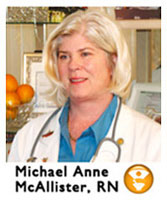Follow IVC
on Facebook
Vitamin
Tweet
Stay up date
on IVC's Blog
Vitamin C & Cancer
Videos
ProArgi9 Nutritional Suppliment
Age Management Infusions
A mixture vitamins and minerals varying in dosage and strenghts based on patients needs. By supplying the missing vitamins, nutrients and minerals that the body cannot store, cellular heath is maintained and cell repair and elasticity are improved as they are saturated with elements they no longer store.
Alpha Lipoic Acid (ALA)
Alpha-lipoic acid (ALA) is a synthetic version of lipoic acid a water / fat-soluble antioxidant that is made by the body and is found in every cell, where it helps turn glucose into energy. Antioxidants are substances that attack "free radicals," waste products created when the body turns food into energy. Free radicals cause harmful chemical reactions that can damage cells in the body, making it harder for the body to fight off infections. They also damage organs and tissues.
ALA is found in mitochondria and plays a role in energy production. It increases the antioxidant effects of vitamins C and E, and of glutathione (peptide containing amino acids, functioning as a coenzyme in oxidation-reduction reactions) and supports the detoxifying abilities of the liver. Glutathione, a major cellular antioxidant, can be regenerated by alpha lipoic acid in concert with other antioxidants.
As a chelator, ALA can trap metals in the blood circulation, thus preventing cellular damage. Alpha lipoic acid may enter nerve tissue and prevent glucose-related oxidative damage. A number of epidemiological studies have found a link between antioxidant intake and a reduced incidence of dementia, AD and cognitive decline in elderly populations.ALA increases glucose uptake through recruitment of the glucose transporter-4 to plasma membranes, a mechanism that is shared with insulin-stimulated glucose uptake. It has been demonstrated that ALA improves glucose disposal in patients with type 2 diabetes.
Ascorbic Acid (Vitamin C)
Can't tolerate antibiotics? Intravenous vitamin C is an immune system booster with anti-viral, anti-bacterial and anti-histamine properties. Receiving a vitamin C infusion instead of antibiotics for common problems such as a urinary tract infection is a healthier option when antibiotics are of concern. People who suffer reoccurring viral infections such as warts or herpes find long term relief without the need for medication. It also offers protection from common ailments such as cold and flu viruses. Last winter our clinic was filled with people getting vitamin C infusions when flu vaccines were unavailable. None of our vitamin C recipients suffered from the flu or other common viral infections.
Cellular Health
When we were born, 80% of our cell membranes were comprised of essential fatty acids which made the cells flexible and healthy. As we age cholesterol replaces these essential fatty acids making the membranes hard, thick and impermeable to nutrients. When the cholesterol is removed with Phospholipid Exchange IV treatments, then glutathione is introduced immediately after to replace the cholesterol that was removed with fatty acids. This brings back the health of our cells, lowers the body's cholesterol and makes the cells more receptive to nutrients.
Chelation Therapy
Chelation Therapy is a recognized treatment for heavy metal (such as lead) poisoning. EDTA, injected into the blood, will bind the metals and allow them to be removed from the body in the urine.
EDTA infusion, which has the ability to remove metal ions, stops or slows metals which are significant causes of free radical production. In removing metals, local toxicity is reduced and enzyme production and function improves. We should not underestimate the role of toxic metal ions in the body, whether these are of lead, mercury, cadmium, copper, iron or aluminum. Once these have been chelated by EDTA and removed from their deposition sites, free radical activity and consequent disruption of metabolic function is largely prevented. Once this has happened normal enzyme function resumes.
A further well-established effect of EDTA infusion involves the improvement of cell membrane integrity and consequent protection of mitochondria activity. If this is happening in the heart muscle itself, such improvement in cell function (enhanced energy production via enhanced mitochondria activity) often allows a strong chance of salvaging and regenerating previously damaged muscle function, with benefits to the heart and therefore the body as a whole.
Chemotherapy
Chemotherapy, in its most general sense, is the treatment of a disease by killing micro-organisms or cancerous cells. Most commonly, chemotherapy acts by killing cells that divide rapidly, one of the main properties of most cancer cells. This means that it also harms cells that divide rapidly under normal circumstances.
Cholesterol and High Density Lipoprotein (HDL) levels
As we age there is an increasing tendency for our blood-cholesterol levels to rise. High blood cholesterol was for many years used alone as a marker of increased risk of cardiovascular disease. The fashion for blaming all cholesterol has only partly been reduced in the public mind through education, but medical practitioners now know that it is only some forms of cholesterol which pose a real threat, the low density forms, (LDL).
Indeed the ratio between total cholesterol and high density lipoprotein beneficial form (HDL) is now used as a clear indication of relative safety or danger, in terms of being a predictor of cardiovascular disease. In a series of simple but effective experiments, McDonagh, Rudolph, and Cheraskin (1982b) have shown that EDTA infusion has a markedly beneficial effect on this potentially serious problem. The effects on over 200 patients with varying levels of HDL cholesterol measurements were quite dramatic. Those who initially showed low levels of HDL rose to normal levels, those with normal levels remained unaltered, and those with high levels of LDL (dangerous) dropped to normal ranges after EDTA chelation therapy supported with vitamin and mineral supplementation.
Detoxification
One of the most challenging difficulties we face is that of detoxification of neurotoxins from infection, chemicals and heavy metals that often reside deep in fatty tissue and organs. Our approach to detoxification is from a cell membrane perspective with respect to essential fatty acid metabolism establishing phospholipid stability.
Neurotoxins are minute compounds that on enter the body, tends to bind to structures that are rich in fat such as most of our cells, especially the liver, kidney, and brain. Neurotoxins are capable of dissolving in fatty tissue and moving through it, crossing cell membranes (transporting against a gradient, particularly with potassium) and disrupting the electrical balance of the cell itself.
Unhealthy bacteria have been known to colonize the liver and its biliary system. These bacteria as well as viruses, spirochetes, dinoflagellates, and the like can synthesize very long chain saturated or renegade fats (Harrington et al 1968, Carballerira et al 1998) that lead to liver toxicity, biliary congestion, impairment of prostaglandin synthesis and the release of glutathione (Ballatori et al 1990). Lipids vibrate in the cell at millions of times/second. The double bonds of the omega 6 and omega 3 lipids are the singing backbone of life expressed through their high energy level. These bonds are their vibratory song, and they absolutely carry a tune befitting every act and function in the exercise of life, providing all 70 trillion of our cells their flexible nature. When renegade fats are over represented in the cell membrane they result in off key expression, and if strong enough, may spell cellular death and apoptosis. Healing the outer leaflet of the membrane (Schachter et al 1983), comprised primarily of phosphatidylcholine, with phospholipid therapy, is our highest priority in addressing chronic illness and hypercoagulation.
By stabilizing lipid status with intravenous Phospholipid exchange and EFA supplementation we have remarkable tools to unload the body’s burden of neurotoxins (Jenkins et al 1982, Cariso et al 1983, Jaeschke et al 1987, Kolde et al 1992) in both pediatric and adult populations, without side effects. The use of phospholipids in a Liver Flush is also an effective intervention in addressing neurotoxic syndromes and lowering cholesterol.
Through isolating individual fatty acids in red cells we can now examine the cellular integrity/structure, fluidity, the formation of renegade fats that impair membrane function, and the intricate circuitry of the prostaglandins. The systemic health of the individual patient may be reached and targeted nourishment utilized through evidence based intervention which may yield positive patient outcomes. Healing the membrane is virtually.…..healing the brain.
Ethylenediaminetetraacetic acid
Widely abbreviated EDTA it is a polyamino carboxylic acid; colorless and a water-soluble solid. Its conjugate base is named ethylenediaminetetraacetate and its usefulness arises because of its role as a hexadentate ("six-toothed") ligand and chelating agent. It has the ability to “wrap” metal ions by one or more polydentate ligands such as Ca2+ and Fe3+ and after being bound by EDTA, metal ions remain in solution but exhibit diminished reactivity. EDTA is produced as several salts, notably disodium EDTA and calcium disodium EDTA
Free radicals
Free radicals play an important role in a number of biological processes, some of which are necessary for life, such as the intracellular killing of bacteria by phagocytic cells such as granulocytes and macrophages. Free radicals have also been implicated in certain cell signaling processes. This is dubbed redox signaling. The two most important oxygen-centered free radicals are superoxide and hydroxyl radical. They are derived from molecular oxygen under reducing conditions. However, because of their reactivity, these same free radicals can participate in unwanted side reactions resulting in cell damage.
Many forms of cancer are thought to be the result of reactions between free radicals and DNA, resulting in mutations that can adversely affect the cell cycle and potentially lead to malignancy. Because free radicals are necessary for life, the body has a number of mechanisms to minimize free radical induced damage and to repair damage that occurs, such as the enzymes superoxide dismutase, catalase, glutathione peroxidase and glutathione reductase.
Glutathione
Glutathione is the antioxidant that is prevalent in every cell in the human body. Glutathione is primarily synthesized in the liver where it is abundantly present. 80-90% of the blood that leaves the stomach and intestines passes through the liver. The blood carries important nutrients to the liver where they are metabolized into substances vital to life. In the same way, exogenous toxic substances reach the liver where they are either activated or transformed into less toxic derivatives. Glutathione plays a crucial role in the liver’s biotransformation system.
Free radicals and oxyradicals play an important role in the development and progression of many brain disorders such as brain injury, neurodegenerative* disease (neurodegeneration is the umbrella term for the progressive loss of structure or function of neurons, including death of neurons), schizophrenia and Down syndrome. Glutathione is the brain's master antioxidant and plays an important protective role in the brain. Free radicals and oxidative damage in neurons is known to be a primary cause of degenerative diseases like Alzheimer's disease.Amyloid plaques encroaching on the brain increase the production of free radicals, or oxidative stress. Antioxidants, such as vitamin C and E remove the damaging free radicals. Glutathione can prevent the death of brain cells induced by amyloid plaques in Alzheimer's disease. Taking glutathione itself as a supplement does not boost cellular glutathione levels, since it breaks down in the digestive tract before it reaches the cells. However, intravenous glutathione therapy along with dietary supplements are effective in boosting intracellular levels of glutathione.
Heavy Metal or Toxic Metal
Living organisms require varying amounts of heavy metals: iron, cobalt, copper, manganese, molybdenum and zinc are needed by humans but excessive levels can be damaging. Other heavy metals such as mercury, plutonium and lead are toxic metals that have no beneficial effect and when accumulated can cause serious illness. Some of these metals can sometimes imitate the actions of essential elements in the body, interfering with the metabolic process and cause illness. Heavy metal occurs mainly from pollution in air and water sources that the body accumulates over time. Unlike organic pollution, heavy metals do not decay and present different challenges for remedies. Decontamination for toxic metals is different from organic toxins because toxic metals are elements and cannot be destroyed. Toxic metals may be made insoluble or collected, possibly by the aid of chelating agents.
Hydration
Water is one of the most essential components of the human body. Water regulates the body’s temperature, cushions and protects vital organs, and aids the digestive system. Water not only composes 75 percent of all muscle tissue and about 10 percent of fatty tissue, it also acts within each cell to transport nutrients and dispel waste. And, because water composes more than half of the human body, it is impossible to sustain life for more than a week without it.
Myer's Cocktail
A mixture of relatively high doses of five vitamins and two minerals. Very often it is customized with varying doses of each agent and can also include Adrenal Cortical Extract (ACE), Glyceron (an extract from the licorice plant named glycerrhizin, which by the way has been shown by recent studies in the Orient as one of the best ways to treat SARS) and Glutathione (a potent antioxidant). It is quickly (within 30 minutes) infused through an IV and in some patients the effects may last weeks. The theory behind high dose and quick infusions is that these vitamins and minerals are forced into the cells by sheer overload and are hence "trapped" intracellularly, where their effects last long beyond the expected short time following the slow infusion.
Phospholipid Exchange (phosphatidylcholine)
Phosphatidylcholine is found in soy lecithin. It can be taken as dietary lecithin or as a supplement for high cholesterol, atherosclerosis (fat deposits on arteries), high blood pressure, liver problems, bipolar depression, dementia, dyskinesias (difficulty making movements), gallbladder disease, headache, and multiple sclerosis. It is used for the skin in treating acne, rosacea and psoriasis.
“Phosphatidylcholine levels in brain cell membranes decline with age, perhaps contributing to memory loss.” Several studies using healthy volunteers have shown an improvement in memory and cognitive function after using phosphatidylcholine to increase acetylcholine levels. This supplement seems to work best when it's used on a preventive basis, or when the memory disorder is relatively mild. Phosphatidylcholine has even been evaluated in Parkinson’s disease (Tweedy 1982). Phosphatidylcholine increases brain function and slows the progression of Parkinson's disease.
Protocol
A protocol is designed to safeguard the health of the participants as well as answer specific research questions. The protocol describes schedule of tests, procedures, medications, and dosages. the patient’s health is monitored to determine the safety and effectiveness of the treatment(s) they are receiving.
Radiation therapy
Radiation therapy (XRT), is the medical use of ionizing radiation as part of cancer treatment to control malignant cells and may used as a primary or adjuvant modality. It is also common to combine radiation therapy with surgery, chemotherapy, hormone therapy or some mixture of the three. Most common cancer types can be treated with radiation therapy in some way. The precise treatment intent will depend on the tumor type, location, and stage, as well as the general health of the patient.Removal of calcium from plaque
Removal of calcium from plaque
Once a localized area of plaque has accumulated in an artery, following some degree of local irritation and subsequent repair (which the plaque represents to a large extent), there exists a strong case for trying to remove any calcium in the plaque in order to prevent its inevitable build up towards this becoming a complete obstruction.
It is the loosely bound calcium in the plaque, held by an electrostatic charge, which prevents the body from dissolving it. When EDTA is infused it mops up the ionic calcium in the blood serum, triggering release of parathormone. This produces a demand for calcium in the blood and this is first mobilized from the calcium deposited in metastatic sites (plaque, soft tissue deposits, etc.), thus allowing the process of resorption of the plaque material and restoration of normal arterial status.
However, this does not happen quickly. It is only by repetitive, very slow infusions of EDTA that the process takes place safely."Does this damage bone and tooth structure?" On the contrary, the status of bone is enhanced after a series of EDTA chelation infusions. This is directly related to the influence of the parathyroid hormone. After EDTA infusion there is a rapid removal of ionic calcium from the bloodstream (the EDTA/calcium complex is excreted via the kidneys). The resulting drop in circulating calcium stimulates parathyroid hormone production which results in the removal of ionic calcium from metastatic deposits (such as occur in plaque). At the same time a phenomenon occurs in response to parathormone, described by Doctors Rasmussen and Bordier (1974), in which preosteoblasts are converted into osteoblasts. Since osteoblasts are the cells which form bone, building the osseous matrix of the skeleton, new bone formation is thus encouraged. This is often confirmed by Xray examination of bone before and after a series of chelation infusions.
Tocopherol and Tocotrienol (Vitamin E)
Vitamin E is a fat-soluble antioxidant that stops the production of reactive oxygen species formed when fat undergoes oxidation. It has been claimed that α-tocopherol is the most important lipid-soluble antioxidant, and that it protects cell membranes from oxidation by reacting with lipid radicals produced in the lipid peroxidation chain reaction. This would remove the free radical intermediates and prevent the oxidation reaction from continuing.





